No products in the cart.
NEWS
Common Cucumber Growing Problems and How to Solve Them
Cucumbers are a cherished crop for many home gardeners, promising crisp, refreshing treats perfect for salads, sandwiches, or enjoying fresh off the vine. Their high water content makes them especially popular during warm weather, providing a delightful crunch and hydration. Successfully growing cucumbers is a rewarding endeavor, typically requiring well-draining, nutrient-rich soil and a location with plenty of sunlight. Gardeners can choose from a diverse range of varieties, suited for slicing or pickling, adding versatility to their harvest.
However, even with ideal conditions, cucumber plants can face challenges from various pests, diseases, and cultivation issues. Observing your plants closely is key to early detection. If you notice your cucumber plants looking less vibrant than usual, exhibiting unusual spots, wilting, or failing to produce fruit, it’s likely they are contending with one of these common problems. Understanding the signs and causes is the first step toward healthy plants and a bountiful harvest.
Identifying and Managing Cucumber Pests
Pests can wreak havoc on cucumber plants, damaging leaves, stems, flowers, and even the developing fruit. Timely identification and management are essential to protect your plants.
Cucumber Beetles
If you see small holes or a lace-like pattern appearing on your cucumber plant leaves, cucumber beetles might be the culprits. These attractive insects, often yellow-green with black stripes or spots, are common pests affecting over 200 plant types, including many in the cucurbit family. They chew on leaves, leaving behind characteristic damage, and may also feed on stems and flower buds. Beyond direct damage, both striped and spotted varieties of cucumber beetles are notorious vectors for devastating diseases like bacterial wilt.
Managing these pests early can prevent significant issues. Inspect plants regularly for their presence or signs of feeding. Applying a natural control such as neem oil to the foliage at the first indication of damage can help. Neem oil disrupts the beetles’ feeding habits and life cycle, ultimately leading to their demise.
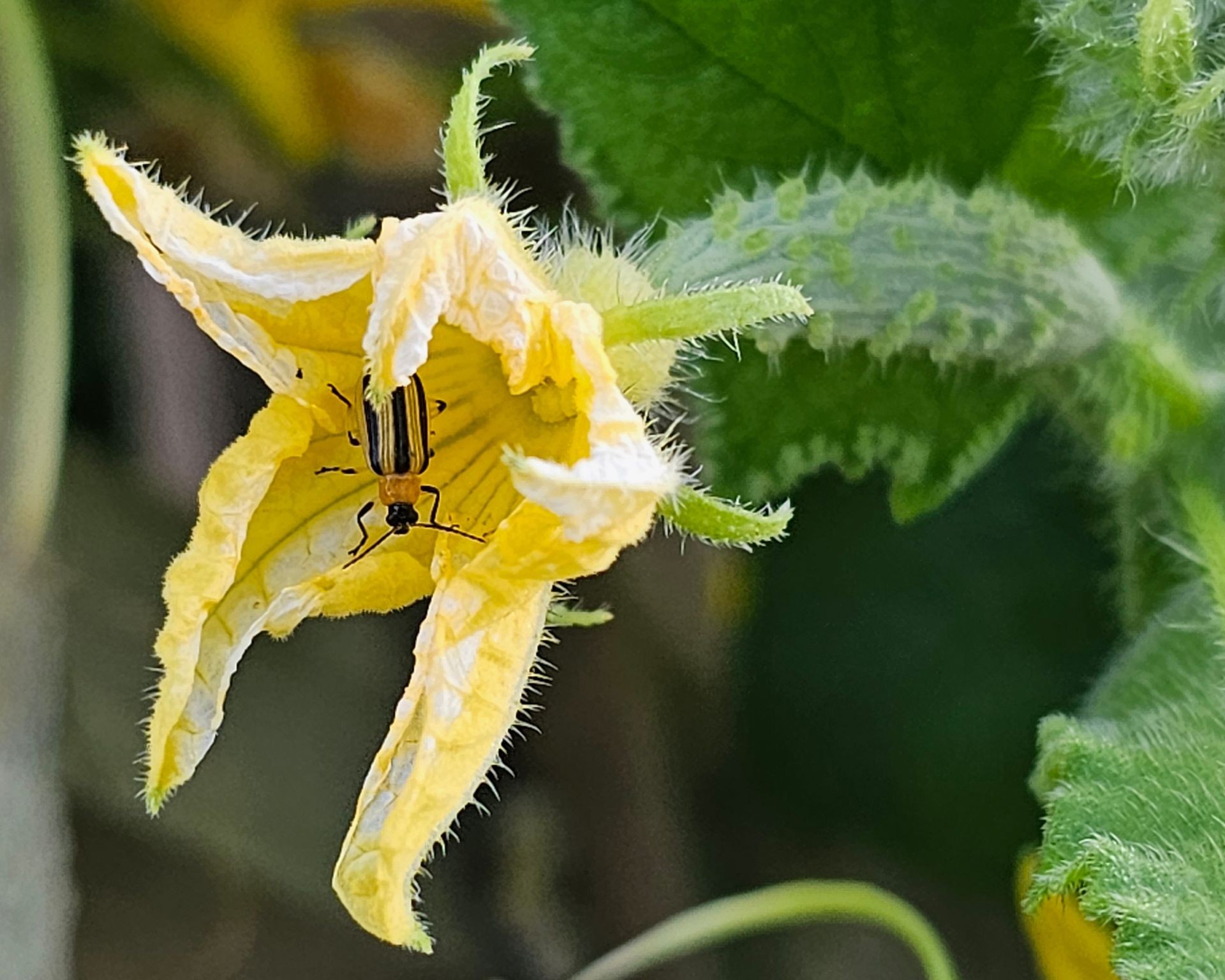 Striped cucumber beetle in flower on cucumber plant
Striped cucumber beetle in flower on cucumber plant
Spider Mites
Despite their minuscule size, spider mites can cause considerable damage to cucumber plants. These tiny arachnids are sucking pests that pierce plant tissues to feed on sap, weakening the plant over time. A large infestation can quickly reduce plant vitality.
Look for reddish and yellow irregular areas on the leaves. You might also notice what appears to be fine webbing or dirt-like specks, especially on the underside of leaves. A simple test involves placing a clean white piece of paper under a leaf and gently shaking it; if tiny specks fall onto the paper and begin to move, you have spider mites. They thrive in hot, dry conditions, often targeting underwatered plants. While beneficial insects like predatory mites or parasitic wasps can be introduced, applying an organic insecticide, such as neem oil, at the first signs of infestation is often an effective immediate measure.
 Visible cobweb, eggs, excrements and spider mites on yellow infected leaves of cucumber
Visible cobweb, eggs, excrements and spider mites on yellow infected leaves of cucumber
Pickleworms
Holes found in ripening cucumbers can be caused by various pests, but pickleworms are a common offender, particularly in warmer climates. These are the larval stage of the pickleworm moth. Their damage is insidious because they bore into the fruit and consume the interior flesh, leaving behind frass (waste) extruded from the entry hole. This internal damage results in mushy, rotting fruit unsuitable for harvest. Pickleworms also feed on flowers, potentially preventing fruit formation altogether.
Preventing adult moths from laying eggs on plants is a primary control strategy. Erecting physical barriers like row covers over young plants can be effective. In cases of significant infestation, targeted insecticidal treatments may be necessary.
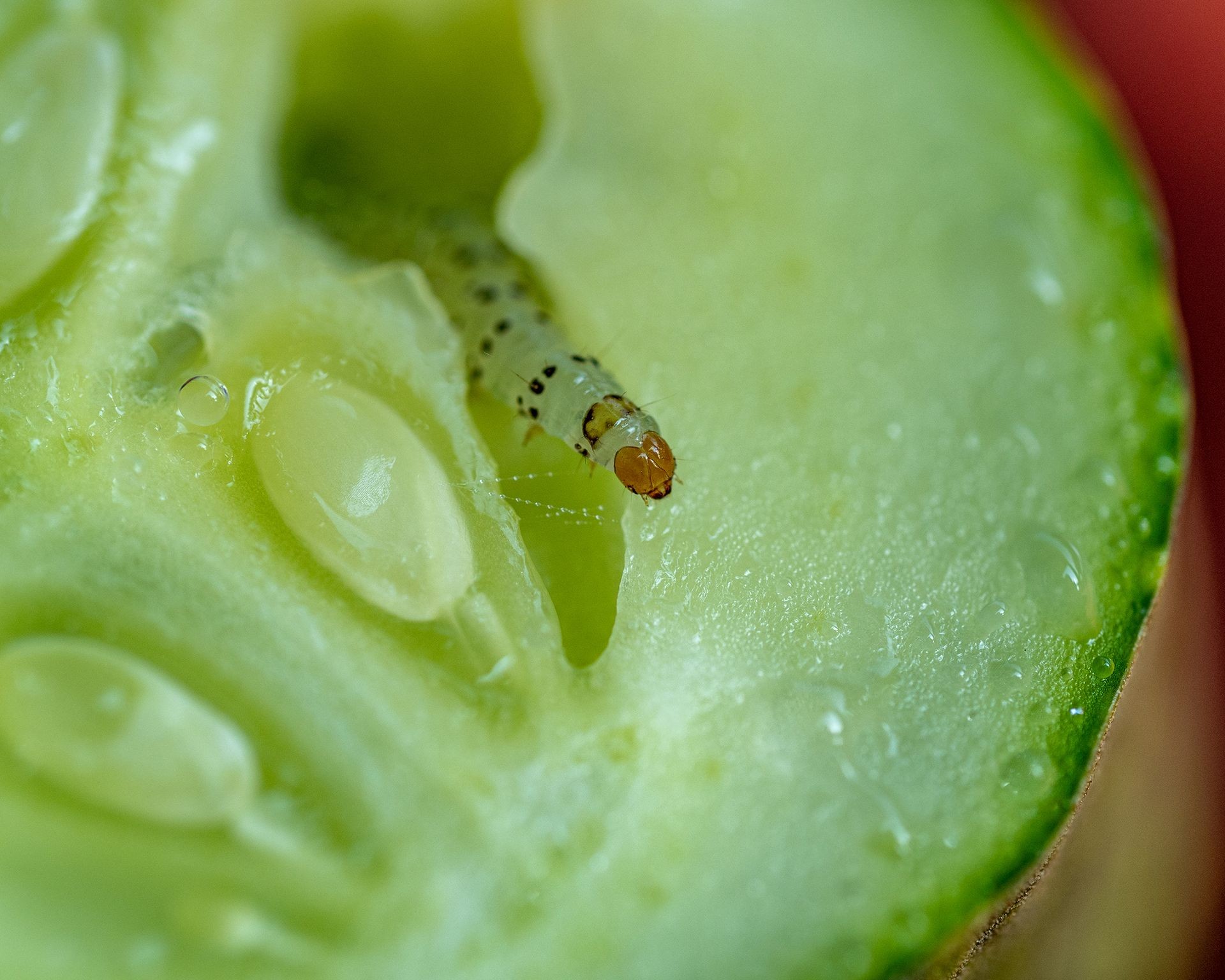 Pickleworm in cucumber
Pickleworm in cucumber
Aphids
While not causing direct structural damage as prominently as beetles or pickleworms, aphids are significant pests of cucumbers primarily because they are vectors for viruses, notably Cucumber Mosaic Virus (CMV). These small, soft-bodied insects feed by sucking sap and can quickly spread diseases from infected plants to healthy ones.
Controlling aphid populations is crucial for preventing the spread of viral diseases. Various methods exist, from washing them off plants with a strong stream of water to using insecticidal soaps or natural predators.
Common Cucumber Diseases
Cucumber plants are susceptible to several fungal, bacterial, and viral diseases that can impact their growth and yield. Recognizing disease symptoms early is vital for effective management.
Bacterial Wilt
A sudden wilting of cucumber leaves and vines, appearing as though the plant is severely underwatered even when the soil is moist, is a tell-tale sign of bacterial wilt. This serious disease is transmitted primarily by striped cucumber beetles that carry the bacteria overwintering in their bodies. When the beetles begin feeding in spring, they introduce the bacteria into the plant’s vascular system.
Once inside, the bacteria multiply, blocking the vessels that transport water throughout the plant. Sadly, there is no cure for bacterial wilt; infected plants will inevitably decline and die. Prompt removal and destruction of infected plants from the garden area are necessary to prevent further spread. Selecting wilt-resistant cucumber varieties is the most effective preventative measure.
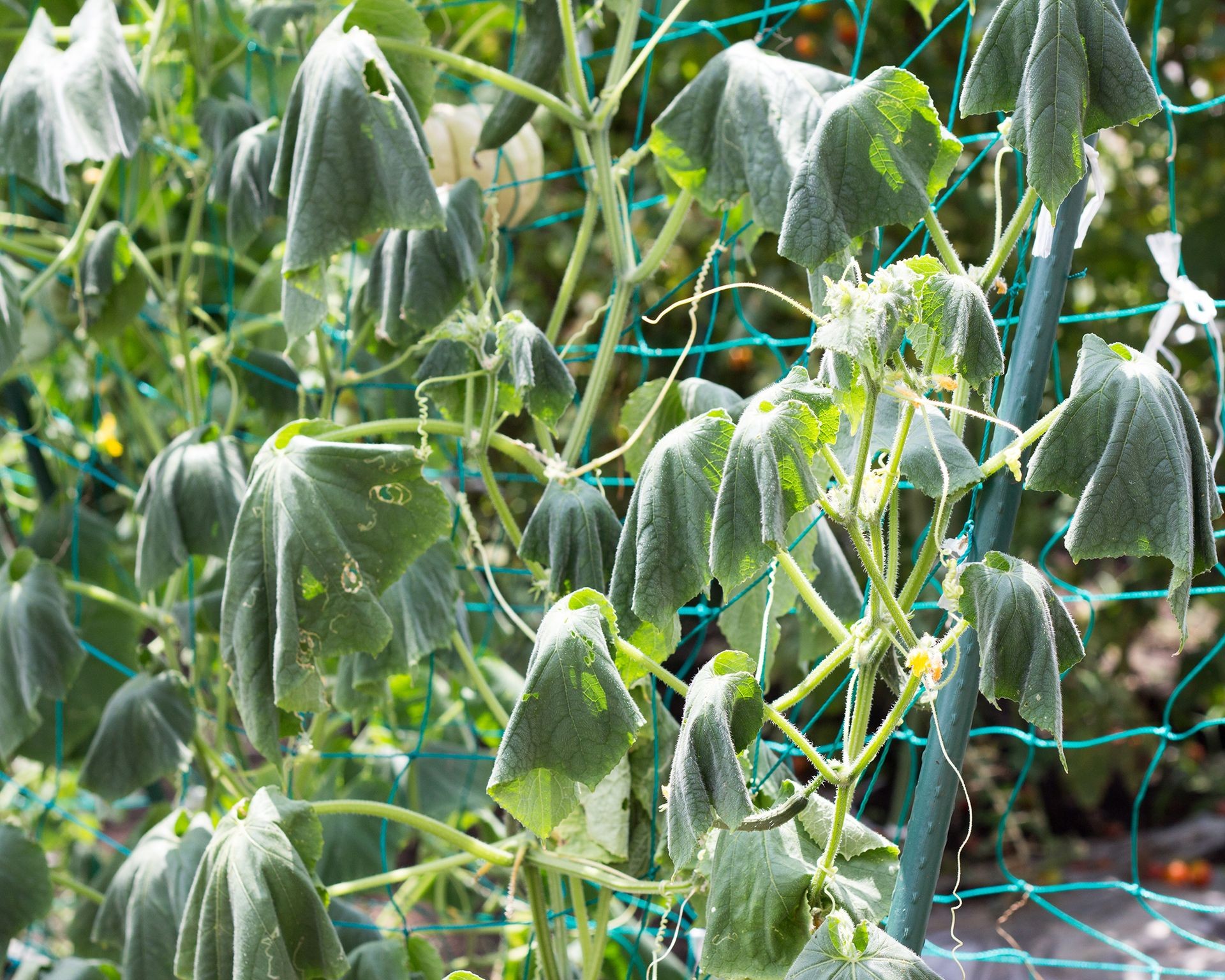 Wilting cucumber plants
Wilting cucumber plants
Anthracnose
Anthracnose is a common fungal disease that can affect cucumbers, especially in warm, wet, and humid conditions. Initial symptoms often appear on the leaves as water-soaked, yellowish spots that enlarge and turn brown with irregular margins. On stems and leaf stalks (petioles), the disease manifests as elongated, sunken tan cankers. Maturing fruit can also be affected, developing soft, dark lesions that may exude pinkish spores.
The fungus often overwinters in plant debris from the previous season. Therefore, thorough garden cleanup in the fall and practicing crop rotation, avoiding planting cucurbits in the same spot year after year, are key preventative strategies. Applying appropriate fungicides at the first sign of symptoms can help manage the disease’s spread. Choosing disease-resistant cucumber varieties is also highly recommended.
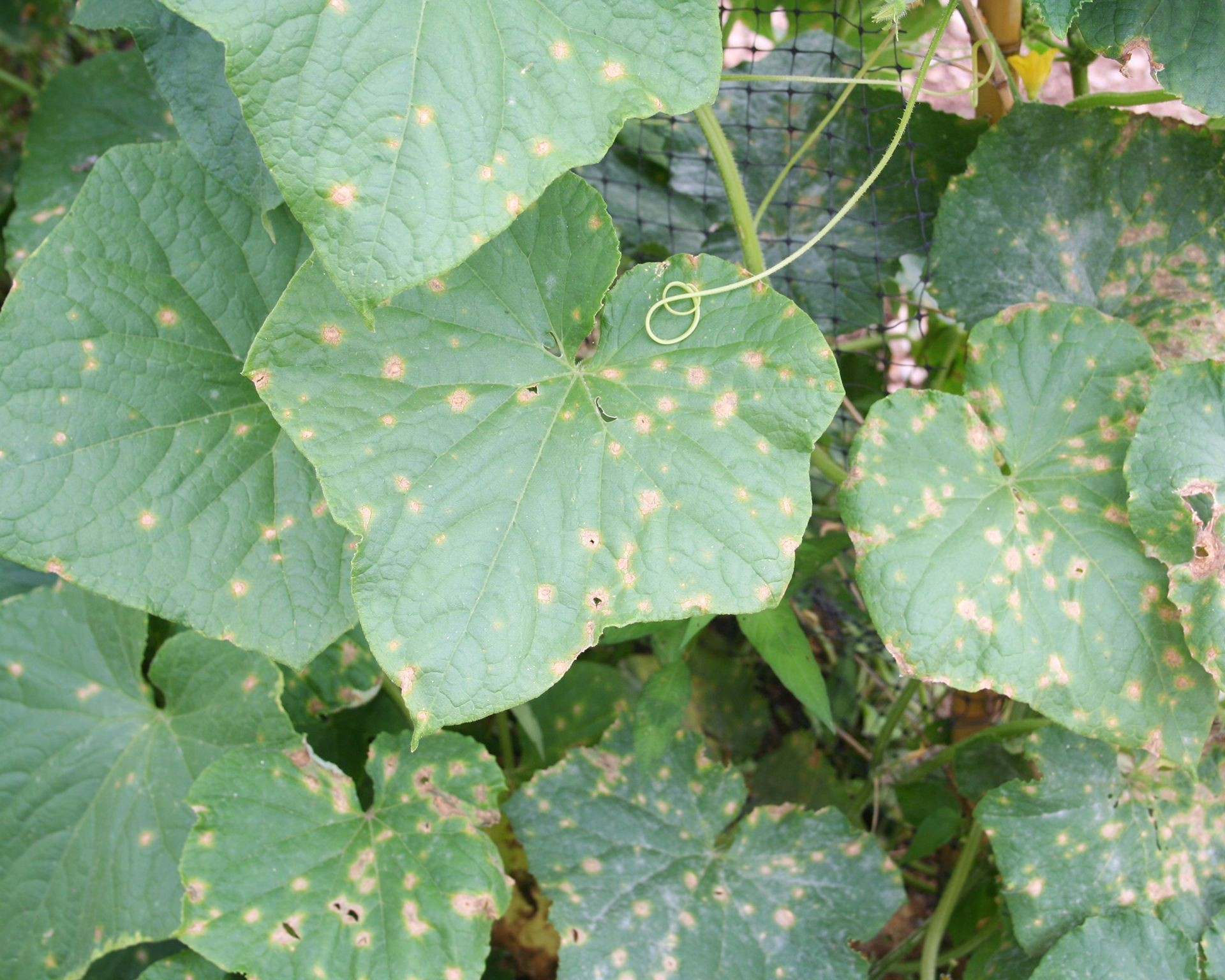 Cucumber plant showing anthracnose on leaves
Cucumber plant showing anthracnose on leaves
Powdery Mildew
Powdery mildew is a ubiquitous fungal disease easily recognized by the white to grayish, powdery patches that appear on the surface of leaves and sometimes stems. It often starts as small spots and can quickly spread to cover entire leaves. This fungus is particularly prevalent in mid to late summer, favoring warm, dry conditions with high humidity. Spores are easily carried by the wind.
Severe infections reduce the plant’s ability to photosynthesize, leading to leaf yellowing, drying, and premature drop. While the fruit itself is rarely directly infected, reduced foliage can lead to smaller fruit production and increased risk of sunscald on the developing cucumbers. Good air circulation around plants, achieved through proper spacing, helps prevent the disease. Using resistant cucumber varieties is another excellent preventative method. Fungicidal treatments can be used to control widespread infections.
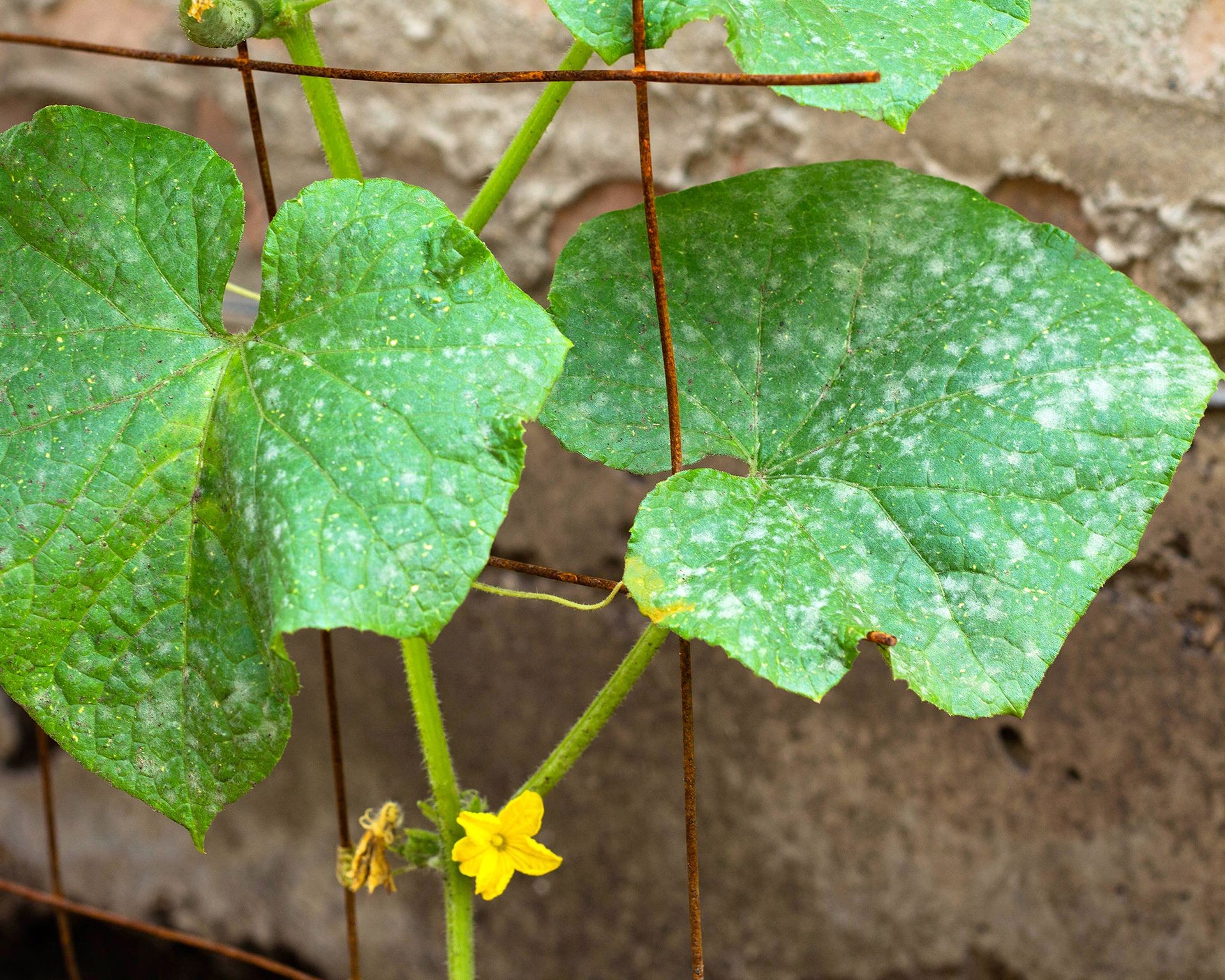 Powdery mildew on cucumber leaves
Powdery mildew on cucumber leaves
Cucumber Mosaic Virus (CMV)
Cucumber Mosaic Virus is a significant viral disease affecting many cucurbit plants. It is primarily spread by aphids. These sap-sucking insects transmit the virus as they feed, introducing it directly into the plant’s vascular tissue.
Symptoms typically appear about six weeks after planting. Leaves develop a characteristic mottled pattern with patches of light and dark green, yellow, and white. Plant growth becomes severely stunted, and affected plants produce few, if any, fruits. Any fruit that does form may be small, deformed, and have a pale grayish-white or mottled appearance. Unfortunately, there is no cure for CMV. Once a plant is infected, it cannot recover and should be promptly removed and destroyed to prevent the virus’s spread. The best prevention involves controlling aphid populations in your garden.
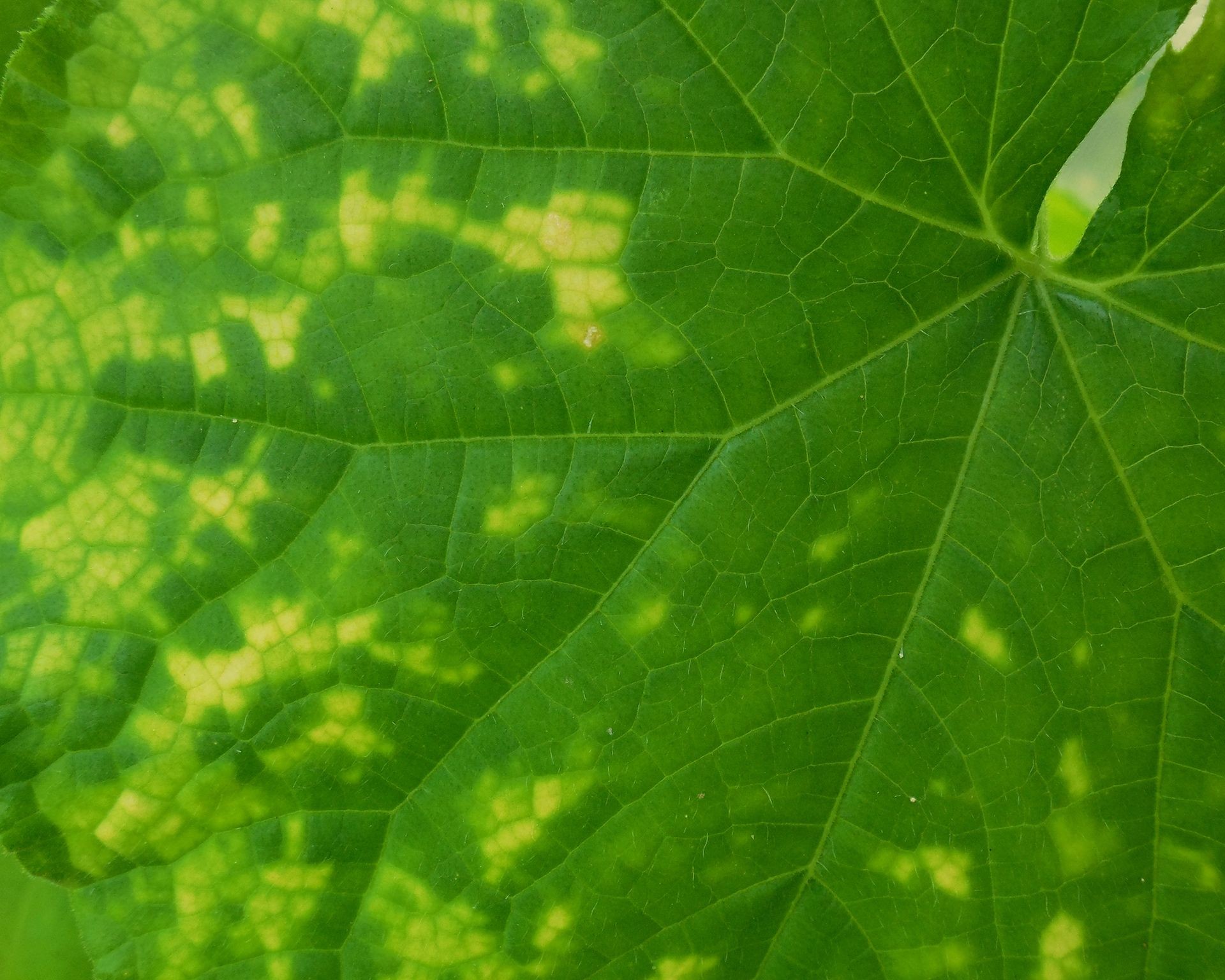 Cucumber mosaic virus on leaves
Cucumber mosaic virus on leaves
Common Cultivation Issues
Sometimes, problems with cucumber plants aren’t caused by pests or diseases but relate to environmental factors and care practices.
Failure to Fruit
One of the most frustrating issues is when your cucumber plants flower profusely but fail to produce fruit. Since you’re growing cucumbers for their delicious yield, a lack of fruit is a major concern. In most cases, this problem stems from inadequate pollination. Low pollination rates can also result in slow-growing or misshapen cucumbers, and sometimes cause young fruits to drop prematurely from the vine.
Cucumbers require pollination to set fruit. If you observe a lack of pollinating insects like bees visiting your garden, consider planting flowers that attract pollinators nearby. Hand-pollinating cucumbers is another effective way to ensure successful fruit set; this involves transferring pollen from the male flowers (which appear first, typically on a slender stalk) to the female flowers (identifiable by the tiny, immature cucumber fruit visible behind the petals) using a small brush. Be patient, as cucumber plants often produce only male flowers initially; female flowers, which develop into fruit, will appear later in the season.
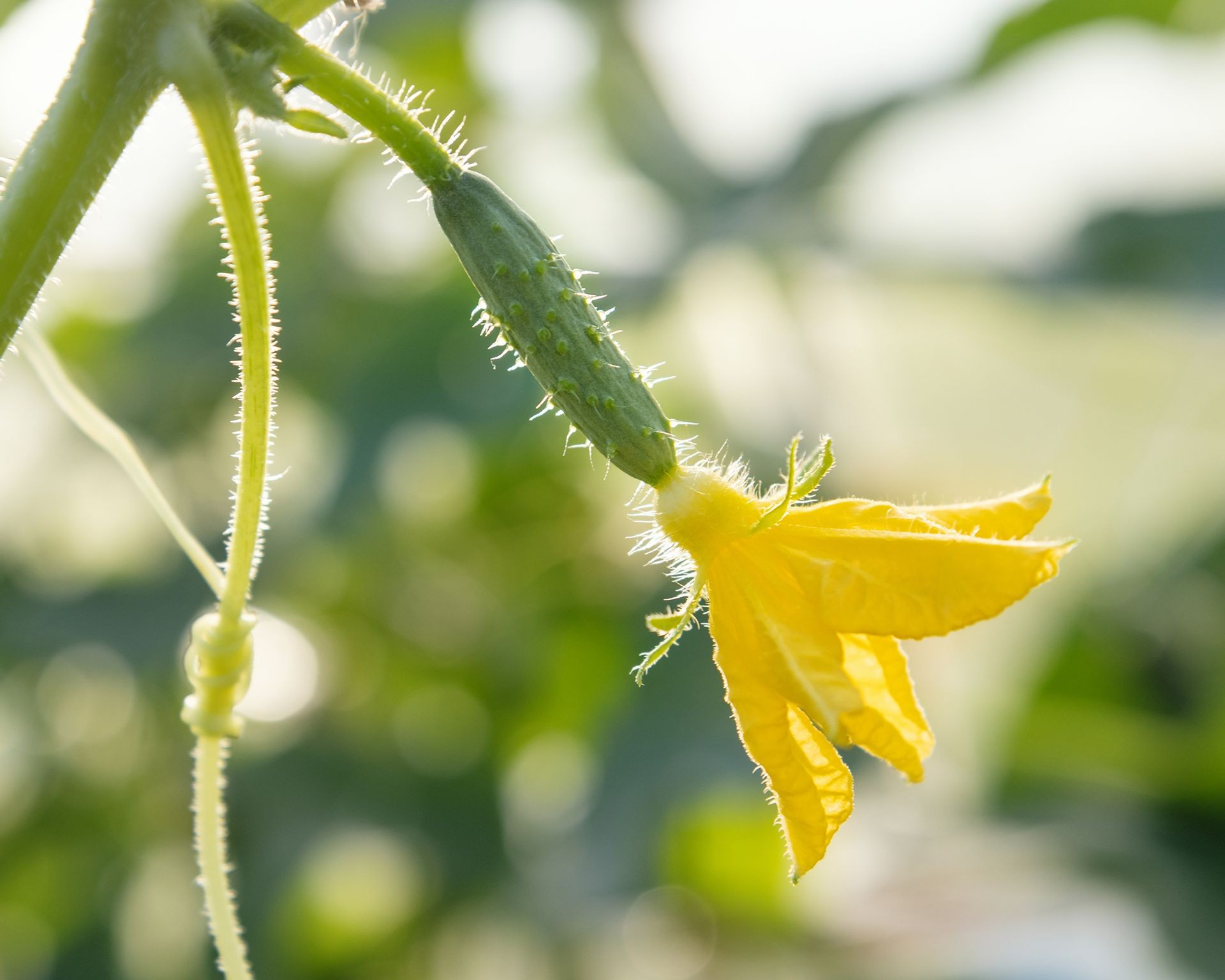 Flower on cucumber plant
Flower on cucumber plant
Yellow Leaves
Yellowing leaves on a cucumber plant (distinct from the mottling caused by CMV or the spots from diseases) are a general indicator that the plant is unhappy due to environmental stress. Common culprits include insufficient water, inadequate nutrients, transplant shock, or too little sunlight.
Given their high water content, cucumbers need consistent moisture, requiring roughly 1 inch (2.5 cm) of water per day, especially as fruits develop. Ensure the soil is kept consistently moist but not waterlogged. Nutritional deficiencies can cause yellowing; incorporating plenty of rich organic matter into the soil before planting provides a good base, and applying a balanced fertilizer twice during the growing season can boost plant health. Cucumbers also need ample sunlight, ideally eight hours or more daily. If plants aren’t receiving enough light, their ability to photosynthesize is reduced, potentially leading to yellowing.
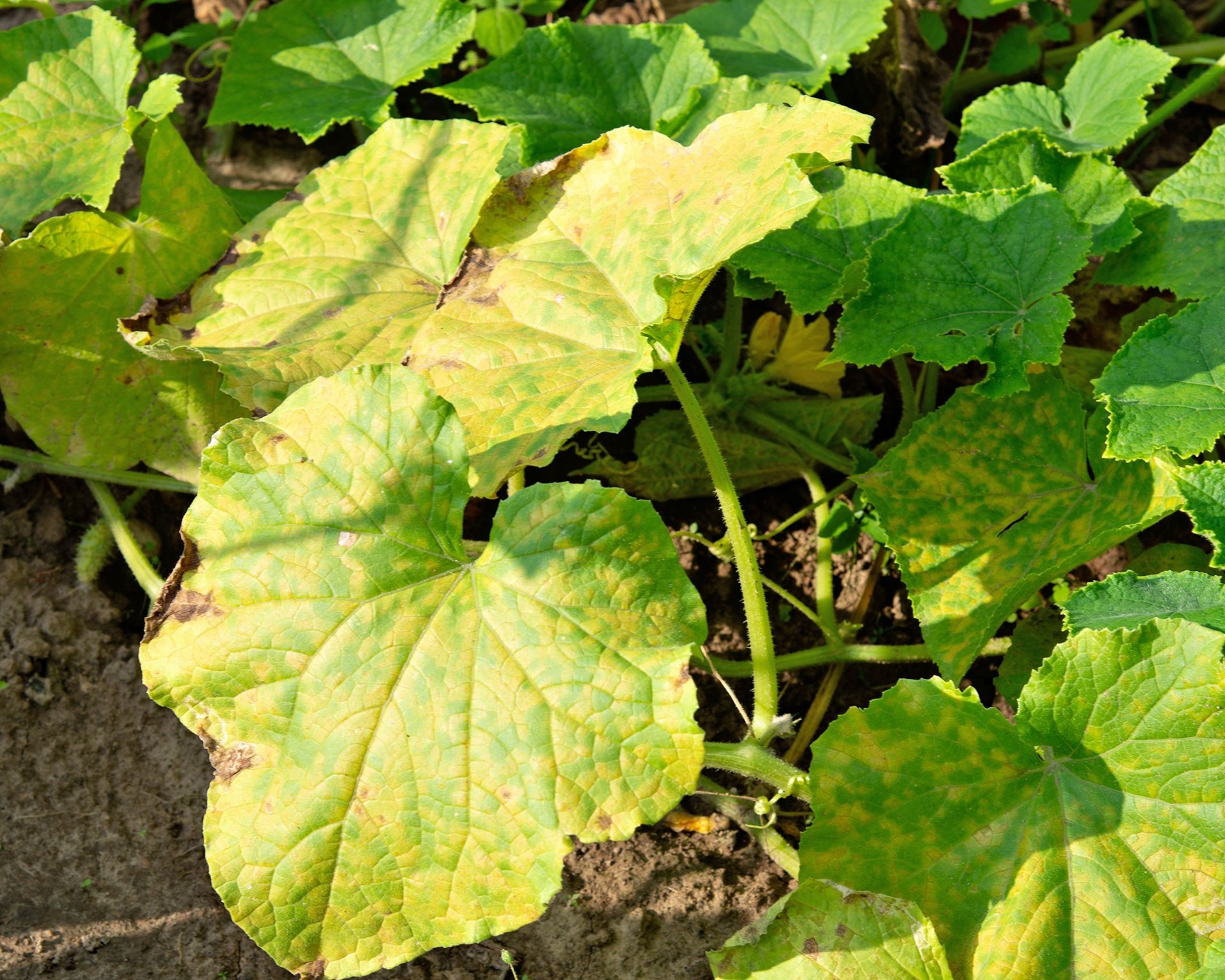 Yellow leaves on cucumber plants
Yellow leaves on cucumber plants
Deformed Fruits
Perfectly formed cucumbers are typically uniform, slender, and gently curved. Deformed fruits, such as those that are pinched at one end or oddly shaped, often signal an issue with inconsistent watering. When a cucumber plant receives insufficient water, or the watering schedule is erratic, the developing fruit can form irregularly. For instance, if the blossom end (the end where the flower was) is plump but the stem end is skinny, it suggests the plant had enough water when the fruit started forming but not as it matured. Consistent, deep watering is crucial for producing well-shaped cucumbers.
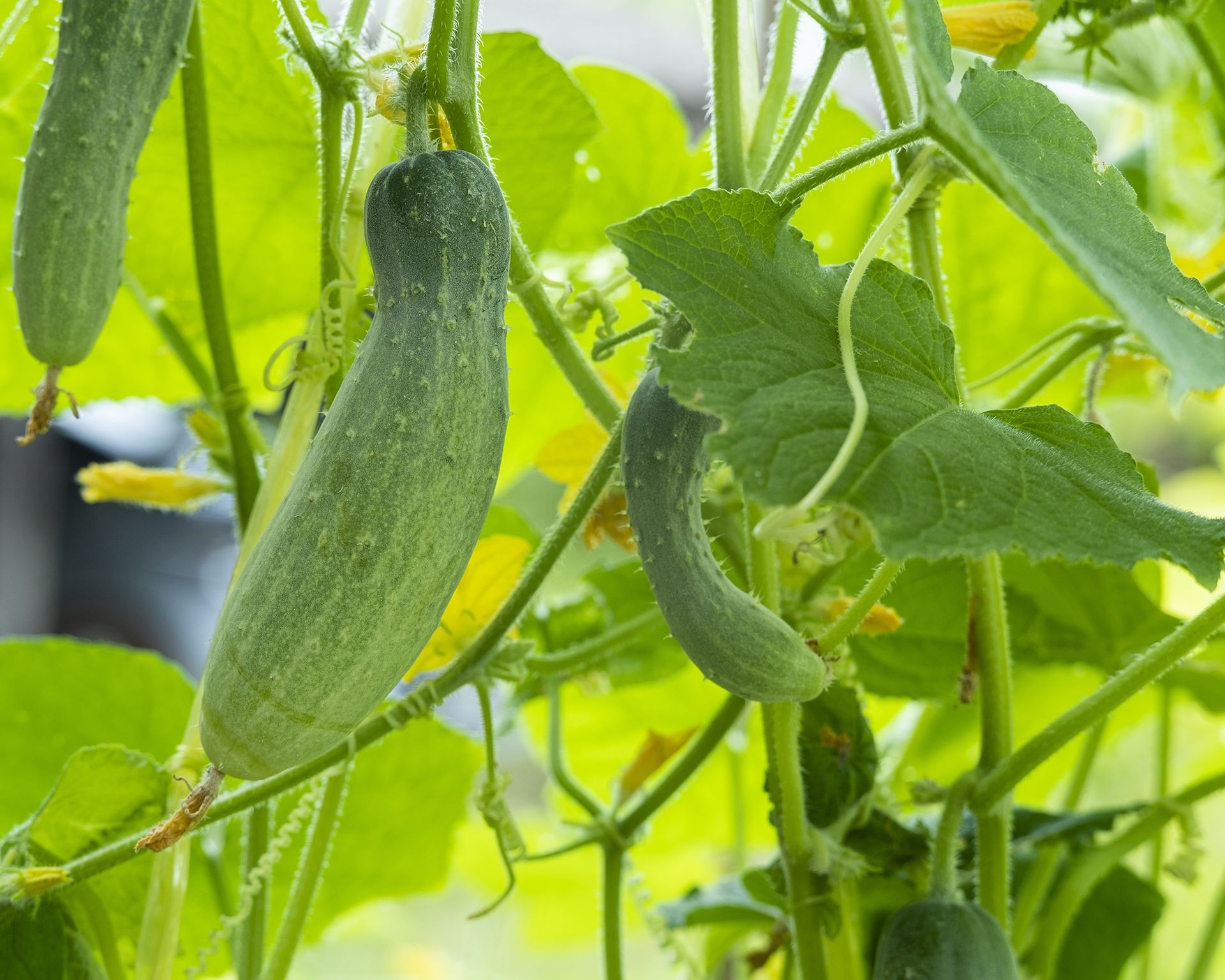 Deformed cucumbers growing on the vine
Deformed cucumbers growing on the vine
Conclusion
Growing cucumbers successfully brings the reward of harvesting your own fresh, crisp produce. While challenges from pests, diseases, and environmental factors are common, they are often manageable with careful observation and timely intervention. Understanding the specific symptoms of common problems – from leaf spots and wilting to pest damage and misshapen fruit – allows you to take appropriate action, whether that involves managing pests with natural controls, addressing nutritional or watering needs, or removing diseased plants.
Maintaining healthy soil, ensuring adequate sunlight and consistent moisture, selecting resistant varieties, and employing good garden hygiene practices like crop rotation and debris cleanup are foundational steps for preventing many issues. When problems do arise, identifying them correctly empowers you to choose the most effective solution. By staying vigilant and applying sound gardening principles, you can minimize losses and enjoy a productive cucumber patch. Explore resources and quality gardening supplies at Biogarden.asia to support your plants’ health from seed to harvest.



